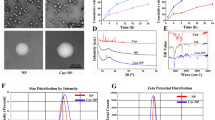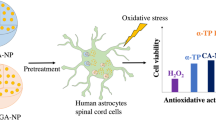Abstract
Neuropathic pain is a devastating chronic condition and effective treatments are still lacking. Carbon monoxide-releasing molecule-2 (CORM-2) as a carbon monoxide (CO) carrier, exerts potent anti-neuropathic pain effects; however, its poor water solubility and short half-life hinder its clinical utility. Therefore, the aim of this study was to investigate whether CORM-2-loaded solid lipid nanoparticles (CORM-2-SLNs) enhance the anti-allodynic and anti-hyperalgesic effects of CORM-2 in a rat chronic constriction injury (CCI) model. CORM-2-SLNs were prepared using a nanotemplate engineering technique with slight modifications. The physiochemical properties of CORM-2-SLNs were characterized and CO release from CORM-2-SLNs was assessed using a myoglobin assay. CO was slowly released from CORM-2-SLNs, was observed, and the half-life of CO release was 50 times longer than that of CORM-2. In vivo results demonstrate that intraperitoneal administration of CORM-2-SLNs (5 and 10 mg/kg/day, ip) once daily for seven consecutive days significantly reduced the mechanical allodynia and mechanical hyperalgesia compared with CORM-2 (10 mg/kg/day, ip). RT-PCR and Western blot analyses on days 7 and 14, revealed that treatment with CORM-2-SLNs resulted in greater reductions in the CCI-elevated levels of heme-oxygenase-2 (HO-2); inducible nitric oxide synthase (iNOS); neuronal NOS (nNOS); and inflammatory mediators (TNF-α, IBA-1, and GFAP) in the spinal cord and dorsal root ganglions compared with treatment with CORM-2. In contrast, HO-1 and IL-10 were significantly increased in the CORM-2-SLN-treated group compared with the group treated with CORM-2. These data indicate that CORM-2-SLNs are superior to CORM-2-S in alleviating mechanical allodynia and mechanical hyperalgesia.










Similar content being viewed by others
Change history
07 February 2019
The original version of this article, the name of author was incorrectely presented. That is Kyungjae Won (K. Won) should be presented as <Emphasis Type="Bold">Jae Won Kyung</Emphasis> (J.W. Kyung).
References
Jurga AM, Piotrowska A, Makuch W, Przewlocka B, Mika J (2017) Blockade of P2X4 receptors inhibits neuropathic pain-related behavior by preventing MMP-9 activation and, consequently, pronociceptive interleukin release in a rat model. Front Pharmacol 8:48
Riego G, Redondo A, Leánez S, Pol O (2018) Mechanism implicated in the anti-allodynic and anti-hyperalgesic effects induced by the activation of heme oxygenase 1/carbon monoxide signaling pathway in the central nervous system of mice with neuropathic pain. Biochem Pharmacol 148:52–63
Jensen TS, Baron R, Haanpää M, Kalso E, Loeser JD, Rice AS, Treede R-D (2011) A new definition of neuropathic pain. Pain 152(10):2204–2205
Finnerup NB, Haroutounian S, Kamerman P, Baron R, Bennett DL, Bouhassira D, Cruccu G, Freeman R et al (2016) Neuropathic pain: an updated grading system for research and clinical practice. Pain 157(8):1599–1606
Ryter SW, Otterbein LE (2004) Carbon monoxide in biology and medicine. Bioessays 26(3):270–280
Wu L, Wang R (2005) Carbon monoxide: endogenous production, physiological functions, and pharmacological application. Pharmacol Rev 57(4):585–630
Motterlini R, Otterbein LE (2010) The therapeutic potential of carbon monoxide. Nat Rev Drug Discov 9(9):728–743
Otterbein LE, Bach FH, Alam J, Soares M, Lu HT, Wysk M, Davis RJ, Flavell RA et al (2000) Carbon monoxide has anti-inflammatory effects involving the mitogen-activated protein kinase pathway. Nat Med 6(4):422–428
Otterbein LE, Zuckerbraun BS, Haga M, Liu F, Song R, Usheva A, Stachulak C, Bodyak N et al (2003) Carbon monoxide suppresses arteriosclerotic lesions associated with chronic graft rejection and with balloon injury. Nat Med 9(2):183–190
Foresti R, Bani-Hani MG, Motterlini R (2008) Use of carbon monoxide as a therapeutic agent: promises and challenges. Intensive Care Med 34(4):649–658
Romao CC, Blättler WA, Seixas JD, Bernardes GJ (2012) Developing drug molecules for therapy with carbon monoxide. Chem Soc Rev 41(9):3571–3583
Marques AR, Kromer L, Gallo DJ, Penacho N, Rodrigues SS, Seixas JD, Bernardes GJ, Reis PM et al (2012) Generation of carbon monoxide releasing molecules (CO-RMs) as drug candidates for the treatment of acute liver injury: targeting of CO-RMs to the liver. Organometallics 31(16):5810–5822
Motterlini R (2007) Carbon monoxide-releasing molecules (CO-RMs): vasodilatory, anti-ischaemic and anti-inflammatory activities. Portland Press Limited
Motterlini R, Haas B, Foresti R (2012) Emerging concepts on the anti-inflammatory actions of carbon monoxide-releasing molecules (CO-RMs). Med Gas Res 2(1):28
Bunjes H (2010) Lipid nanoparticles for the delivery of poorly water-soluble drugs. J Pharm Pharmacol 62(11):1637–1645
Mehnert W, Mäder K (2001) Solid lipid nanoparticles: production, characterization and applications. Adv Drug Deliv Rev 47(2):165–196
Chenglin Y, Yiqun Y, Ye Z, Na L, Xiaoya L, Jing L, Ming J (2012) Self-assembly and emulsification of poly {[styrene-alt-maleic acid]-co-[styrene-alt-(N-3, 4-dihydroxyphenylethyl-maleamic acid)]}. Langmuir 28(25):9211–9222
Severino P, Andreani T, Macedo AS, Fangueiro JF, Santana MHA, Silva AM, Souto EB (2012) Current state-of-art and new trends on lipid nanoparticles (SLN and NLC) for oral drug delivery. J Drug Deliver 1:10
Müller RH, MaÈder K, Gohla S (2000) Solid lipid nanoparticles (SLN) for controlled drug delivery—a review of the state of the art. Eur J Pharm Biopharm 50(1):161–177
Natarajan JV, Nugraha C, Ng XW, Venkatraman S (2014) Sustained-release from nanocarriers: a review. J Control Release 193:122–138
Rippe B (1993) A three-pore model of peritoneal transport. Perit Dial Int 13(Suppl 2):S35–S38
Qureshi OS, Zeb A, Akram M, Kim M-S, Kang J-H, Kim H-S, Majid A, Han I et al (2016) Enhanced acute anti-inflammatory effects of CORM-2-loaded nanoparticles via sustained carbon monoxide delivery. Eur J Pharm Biopharm 108:187–195
Qureshi OS, Kim H-S, Zeb A, Choi J-S, Kim H-S, Kwon J-E, Kim M-S, Kang J-H et al (2017) Sustained release docetaxel-incorporated lipid nanoparticles with improved pharmacokinetics for oral and parenteral administration. J Microencapsul 34(3):250–261
Atkin AJ, Lynam JM, Moulton BE, Sawle P, Motterlini R, Boyle NM, Pryce MT, Fairlamb IJ (2011) Modification of the deoxy-myoglobin/carbonmonoxy-myoglobin UV-Vis assay for reliable determination of CO-release rates from organometallic carbonyl complexes. Dalton Trans 40(21):5755–5761
Motterlini R, Clark JE, Foresti R, Sarathchandra P, Mann BE, Green CJ (2002) Carbon monoxide-releasing molecules: characterization of biochemical and vascular activities. Circ Res 90(2):e17–e24
Bennett GJ, Xie Y-K (1988) A peripheral mononeuropathy in rat that produces disorders of pain sensation like those seen in man. Pain 33(1):87–107
Thiagarajan VR, Shanmugam P, Krishnan UM, Muthuraman A (2014) Ameliorative potential of Vernonia cinerea on chronic constriction injury of sciatic nerve induced neuropathic pain in rats. An Acad Bras Cienc 86(3):1435–1450
Hervera A, Leánez S, Motterlini R, Pol O (2013) Treatment with carbon monoxide-releasing molecules and an HO-1 inducer enhances the effects and expression of μ-opioid receptors during neuropathic pain. Anesthesiol: J Am Soc Anesthesiol 118(5):1180–1197
Shahid M, Subhan F, Ahmad N, Ullah I (2017) A bacosides containing Bacopa monnieri extract alleviates allodynia and hyperalgesia in the chronic constriction injury model of neuropathic pain in rats. BMC Complement Altern Med 17(1):293
Erichsen HK, Blackburn-Munro G (2002) Pharmacological characterisation of the spared nerve injury model of neuropathic pain. Pain 98(1–2):151–161
Zhou C, Shi X, Huang H, Zhu Y, Wu Y (2014) Montelukast attenuates neuropathic pain through inhibiting p38 mitogen-activated protein kinase and nuclear factor-kappa B in a rat model of chronic constriction injury. Anesth Analg 118(5):1090–1096
Guo C-H, Bai L, Wu H-H, Yang J, Cai G-H, Zeng S-X, Wang X, Wu S-X et al (2017) Midazolam and ropivacaine act synergistically to inhibit bone cancer pain with different mechanisms in rats. Oncol Rep 37(1):249–258
Berger JV, Deumens R, Goursaud S, Schäfer S, Lavand’homme P, Joosten EA, Hermans E (2011) Enhanced neuroinflammation and pain hypersensitivity after peripheral nerve injury in rats expressing mutated superoxide dismutase 1. J Neuroinflammation 8(1):33
Levy D, Höke A, Zochodne DW (1999) Local expression of inducible nitric oxide synthase in an animal model of neuropathic pain. Neurosci Lett 260(3):207–209
Kim D-S, Figueroa KW, Li K-W, Boroujerdi A, Yolo T, Luo ZD (2009) Profiling of dynamically changed gene expression in dorsal root ganglia post peripheral nerve injury and a critical role of injury-induced glial fibrillary acetic protein in maintenance of pain behaviors. Pain 143(1–2):114–122
Olmos G, Lladó J (2014) Tumor necrosis factor alpha: a link between neuroinflammation and excitotoxicity. Mediat Inflamm
Bijjem KRV, Padi SS, lal Sharma P (2013) Pharmacological activation of heme oxygenase (HO)-1/carbon monoxide pathway prevents the development of peripheral neuropathic pain in Wistar rats. Naunyn Schmiedeberg’s Arch Pharmacol 386(1):79–90
Meller S, Dykstra C, Grzybycki D, Murphy S, Gebhart G (1994) The possible role of glia in nociceptive processing and hyperalgesia in the spinal cord of the rat. Neuropharmacology 33(11):1471–1478
Watkins LR, Milligan ED, Maier SF (2001) Glial activation: a driving force for pathological pain. Trends Neurosci 24(8):450–455
Raghavendra V, Tanga FY, DeLeo JA (2004) Complete Freunds adjuvant-induced peripheral inflammation evokes glial activation and proinflammatory cytokine expression in the CNS. Eur J Neurosci 20(2):467–473
Tanabe M, Nagatani Y, Saitoh K, Takasu K, Ono H (2009) Pharmacological assessments of nitric oxide synthase isoforms and downstream diversity of NO signaling in the maintenance of thermal and mechanical hypersensitivity after peripheral nerve injury in mice. Neuropharmacology 56(3):702–708
Kim KM, Pae H-O, Zhung M, Ha H-Y, Ha YA, Chai K-Y, Cheong Y-K, Kim J-M et al (2008) Involvement of anti-inflammatory heme oxygenase-1 in the inhibitory effect of curcumin on the expression of pro-inflammatory inducible nitric oxide synthase in RAW264. 7 macrophages. Biomed Pharmacother 62(9):630–636
Motterlini R, Foresti R (2014) Heme oxygenase-1 as a target for drug discovery. Antioxid Redox Signal 20(11):1810–1826
Liang D, Li X, Lighthall G, Clark J (2003) Heme oxygenase type 2 modulates behavioral and molecular changes during chronic exposure to morphine. Neuroscience 121(4):999–1005
Acknowledgements
This research was supported by the National Research Foundation (NRF) of Korea (NRF2017R1C1B1011397) and Korea Health Technology Research and Development Project, Ministry for Health and Welfare Affairs (HI16C1559, HI18C0183). This work was supported by the Basic Science Research Program of the National Research Foundation of Korea (NRF) funded by the Ministry of Science and ICT (NRF-2017R1A2B4006458).
Author information
Authors and Affiliations
Contributions
IBH and JKK conceived and directed the project. IBH, HPJ, and HK designed the whole experimental plan. HPJ, MJJ, HC, JK, SK, and KW carried out the experiments. SBK, SS, and KTK analyzed the data and interpreted the result. IBH, HPJ, SBK, and SK wrote the paper. All authors reviewed the manuscript.
Corresponding authors
Ethics declarations
Competing Interests
The authors declare that they have no competing interests.
Additional information
Publisher’s Note
Springer Nature remains neutral with regard to jurisdictional claims in published maps and institutional affiliations.
The original version of this article was revised: The original version of this article, the name of author was incorrectely presented. That is Kyungjae Won (K. Won) should be presented as Jae Won Kyung (J.W. Kyung).
Electronic supplementary material
ESM 1
(DOCX 64 kb)
Rights and permissions
About this article
Cite this article
Joshi, H.P., Kim, S.B., Kim, S. et al. Nanocarrier-mediated Delivery of CORM-2 Enhances Anti-allodynic and Anti-hyperalgesic Effects of CORM-2. Mol Neurobiol 56, 5539–5554 (2019). https://doi.org/10.1007/s12035-019-1468-7
Received:
Accepted:
Published:
Issue Date:
DOI: https://doi.org/10.1007/s12035-019-1468-7




